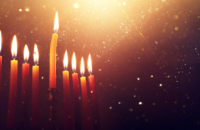Lag B’Omer 5781

A few years ago, I arrived in Jerusalem on the evening of Lag B’Omer. As my Nesher sherut approached the city, I could see through the darkness street lights twinkling on the hills and car lights illuminating the streets and highways. We circled the city, roaming from neighbourhood to neighbourhood to discharge passengers. In each neighborhood, people gathered together around glowing orange bonfires religious and secular, adults, children and teenagers. Throughout the city and country, in vacant lots, on street corners and distant hills the flames of Lag B’Omer burned.
Lag B’Omer marks the thirty third day of the Omer, the 49 day count down from Passover to Shavuot. Though its origins are obscure, it has always had the status of a semi-holiday. It is associated with the deaths of Rabbi Akiva’s 12,000 students. The Babylonian Talmud, Yevamot 62b, teaches that the students did not treat each other with respect and died as a result of a plague. Over time, the semi-mourning customs of the Omer have also come to be associated with the national tragedies which also took place in the Spring: the Crusades and, later, the Chmielnicki massacres of 1648. On Lag B’Omer, the somber tone gives way to celebration and commemorates, according to the Meiri, the end of the Plague.
Lag B’Omer is also associated with the yahrzeit, or Hillula celebration, of Rabbi Shimon bar Yochai’s death. One of Rabbi Akiva’s five pupils who survived the plague; Rabbi Shimon, is also considered to have revealed the mystical text of the Zohar to the world. The tradition of burning bonfires on Lag B’Omer originates with Rabbi Shimon who, it is said, asked his students before his death that they celebrate his life with bonfires and feasting. Bonfires are also meant to be a symbol of the radiance of the mystical tradition which Rabbi Shimon revealed to the world with the Zohar. Yet Rabbi Shimon’s death only came to be associated with Lag B’Omer with the publication of the Kabbalist Rabbi Chaim Vital’s book Pri Etz Hayyim (1782). By the beginning of the 20th century, secular Zionists reinterpreted Lag B’Omer, associating the bonfires with Jewish history rather than with Jewish mysticism; they were symbolic of the mountaintop signal fires lit by Bar Kochba’s fighters in the war against the Romans.
Over time, some rabbis objected to some of the more extreme observances of Lag B’Omer. The Chatam Sofer (Hungary, d. 1839) attacked the custom of throwing expensive clothes into the bonfires on the principle that it violates the prohibition of bal tashchit or wasteful destruction. He also opposed the festivities on the basis that there was no record of Lag B’Omer celebrations in the Talmudic era, in keeping with his position against any innovations in Jewish tradition.
Though the origins of Lag B’Omer are obscure, the idea of fire as an essential element of Jewish practice is ancient. In this week’s sedra, we read about the laws governing the lighting of the menorah in the Mishkan. “Command the Israelite people to bring you clear oil of beaten olives for lighting, for kindling lamps regularly [ner tamid].” (Lev. 24:2). Rashi, commenting on the word tamid, writes: “From night to night”, the lamp was rekindled every evening as it only burned at night. Rashi’s comment suggests a metaphor for the development and adoption of new customs in Jewish tradition. The holiday of Lag B’Omer cannot be found in ancient sources but it’s continued presence and adaptation by the Jewish people to contemporary circumstances demonstrates the Jewish people’s commitment to renewing the Jewish tradition, day to day, year to year, and era to era.




